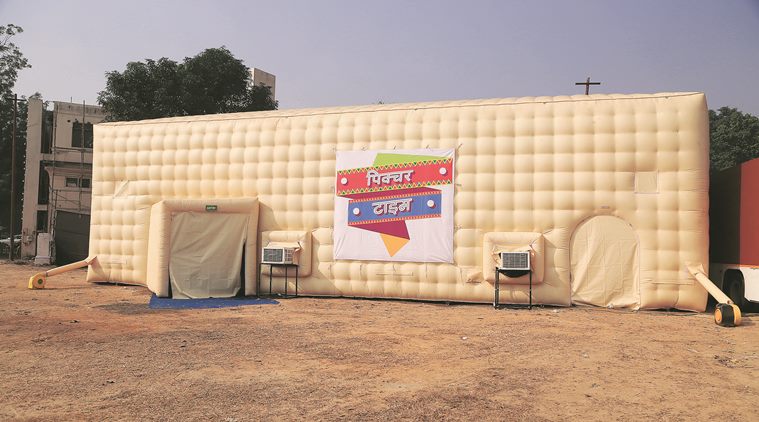Premiering on Wheels
If a multiplex can’t be built in smaller towns, new initiatives ensure it can at least travel there — taking movies to more people.

(Top to bottom) PictureTime’s inflatable digiplex; at one of Caravan Talkies’ screenings; inside the digiplex
Actor Satish Kaushik, that wandering entertainer from Dev Benegal’s Road, Movie who hopped onto an old Chevy across the desert, has been in the news lately for doing something similar in real life. At last year’s International Film Festival of India (IIFI) in Goa, he saw PictureTime’s DigiPlex, which takes multiplex-on-wheels (currently 20 units) to smaller towns, and became its partner for Haryana.
Baahubali was the first film PictureTime, founded in 2015, screened in tier-II and tier-III cities to an overwhelming response. “It can solve the country’s low-screen density problem,” Kaushik had told PictureTime founder and CEO Sushil Chaudhary, who says, the Mobile Digital Movie Theatre is a new territory of cinema exhibition since The Cinematograph Act only recognises the categories of multiplexes, single screens and touring talkies/video-on-wheels.
Baahubali was the first film PictureTime, founded in 2015, screened in tier-II and tier-III cities to an overwhelming response. “It can solve the country’s low-screen density problem,” Kaushik had told PictureTime founder and CEO Sushil Chaudhary, who says, the Mobile Digital Movie Theatre is a new territory of cinema exhibition since The Cinematograph Act only recognises the categories of multiplexes, single screens and touring talkies/video-on-wheels.
“Why did Dangal, an Indian film, do four times more business in China? Because of the sheer width of its distribution. While India is struggling with 10,000 screens (four-five cinema halls for every million population), the number of halls grew in China from 6,000 to 60,000, a growth charted in the tier-II and tier-III cities,” says Kulmeet Makkar, CEO, Film and Television Producers Guild of India. He says that in smaller towns, a permanent structure catering to a small audience isn’t sustainable, hence travelling cinemas, which save on real-estate costs, work.

The inflatable digiplex, which seats 120-150 people, can be installed/dismantled in 2.5 hours and recreates the plush-multiplex experience — air-conditioning, telescopic platform, 5.1 Dolby surround sound delivery, popcorn and soft drinks, even services like the ATM.
“It’s a beat concept,” says Chaudhary, adding, “We stay in one location for 15-20 days and then move on. We get local vendors like the paanwala and barber to promote for us.” The aim was to make the touring talkies “portable, real-estate independent and DCI (Digital Cinema Initiatives) compliant (to make it Day One-release platform)”.
UFO Moviez has been doing something similar through its Caravan Talkies. Not like a multiplex showing first-day-first-shows, but movies-on-wheels reaching villagers for free. It was set up in 2015, the same year PictureTime set up shop. The vans follow the haat/mela. Parked at marketplaces, Caravan Talkies lets advertisers (Wipro, Parle, Dabur, ITC and Coca-Cola, among others) use their vans to engage with villagers, do brand promotion and rural activation during the day and screen films in the evenings.
Growing up in small-town Ambala, Siddharth Bharadwaj, chief marketing officer and national sales head, enterprise business, UFO Moviez, remembers how movies would reach them after a year of release. “Cinema was analogue, a maximum of 400-500 film prints went to the bigger markets,” he says.
Starting with Uttar Pradesh, Madhya Pradesh, Rajasthan, Bihar and Jharkhand, the 114 Caravan Talkies vans have covered 14 states and 5,000-plus villages. In India, there are 2,700-plus locations with a movie theatre, mostly in urban areas, and not as many in the north, says Bharadwaj.
He adds, “Andhra Pradesh alone has 600-700 screens. The thought was to take cinema into the Hindi heartland, where the penetration is low or doesn’t exist.” Bodyguard, Dangal, Baahubali and Ram Teri Ganga Maili have remained hot demands. Gabbar is Back in Sihori (UP), Mithur Ghata in Jaipur (West Bengal) and Lal Baadshah in Banmankhi (Bihar) — each film witnesses a footfall close to 250-1,100.
For PictureTime, the latest blockbuster has been Sanju shown in Chhattisgarh’s Jashpur, Lakhanpur and Bilha. “New releases and old films, whose DCP/digital format are available, are covered,” says Chaudhary. They have fixed the movie ticket price at Rs 35-80, which is “great value for money”, says Makkar, adding, “It will help curb piracy, much like Netflix, Amazon Prime, Saavn and Gaana.”
While “producers like Shobu Yarlagadda (Baahubali) and Shital Bhatia of Friday Filmworks were keen, it took six months to convince YRF/Red Chillies for Day One screening rights,” says Chaudhary, adding, “Most objected initially because of the anti-piracy policy rules laid out by their global partners such Fox Star, Disney and Sony Pictures.” PictureTime is exploring the possibility to screen American distribution company Lionsgate’s films across India.
“Mobile phone is sachet-entertainment consumption,” says Makkar. “It doesn’t make you laugh, cry, or be consumed in a community. The kind of joy we see on people’s faces to see their favourite actors on the big screen is unparalleled,” adds Bharadwaj.
Will these enterprises then hit the business of small-time exhibitors? “PictureTime will have to struggle like the bioscopewallahs too, and won’t have any effect on the economy, unless it gets in investments and grows the base to 1,000-plus theatres,” says Makkar. Having raised Rs 25 crore, plans are afoot for 100 mobile digiplexes covering 14 states by March.






















No hay comentarios:
Publicar un comentario